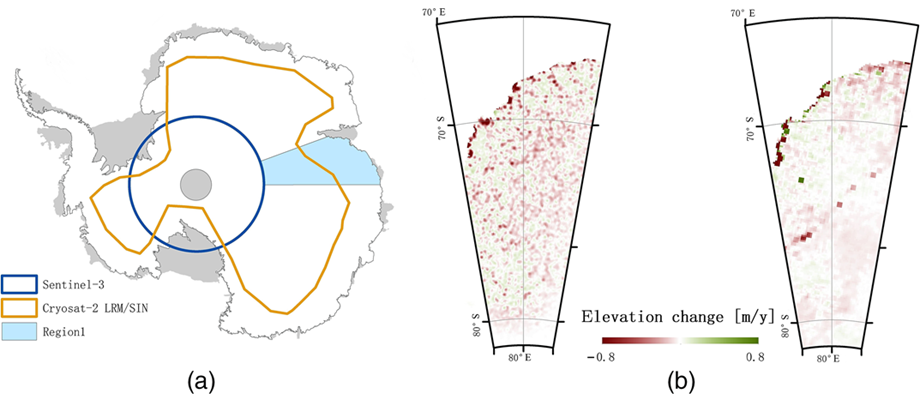Studies have revealed that the melting of the Antarctic ice sheets has accelerated significantly in recent years, making the Antarctic region particularly vulnerable to climate change. Sea levels are continuing to rise globally, and as a result, endangering the lives of people who live along the coast.
 (a) Boundaries of Sentinel-3 (blue circle) and CryoSat-2 (yellow loop). The study region is indicated in light blue. (b) Comparison between the elevation changes in the study region extracted without filtering (left) and with filtering (right). Filtering removes outliers via data clustering, improving the accuracy of the results. Image Credit: The Authors
(a) Boundaries of Sentinel-3 (blue circle) and CryoSat-2 (yellow loop). The study region is indicated in light blue. (b) Comparison between the elevation changes in the study region extracted without filtering (left) and with filtering (right). Filtering removes outliers via data clustering, improving the accuracy of the results. Image Credit: The Authors
Researchers have been closely observing the topography and height of the Antarctic ice sheets for decades due to the possibly catastrophic repercussions of their melting. The majority of the Antarctic region is often covered by satellites fitted with specialized altimeter radars, which offer a nearly constant coverage of the area.
To increase accuracy and precision and to compare data from various time periods, data from many satellite missions are frequently merged. However, due to the many instrumentation and processing methods used, integrating this data is not an easy procedure.
Researchers from the Chinese Academy of Sciences, under the direction of Professor Jingjuan Liao, recently tested a novel methodology that merged elevation data of the Antarctic ice sheet from two separate satellites.
Their aim was to validate their data analysis techniques and obtain a more precise map of the most recent elevation changes in the Antarctic ice sheet. The study was published in SPIE’s Journal of Applied Remote Sensing.
The information used in the study was derived from radar altimeters mounted on CryoSat-2 and Sentinel-3, and it related to changes in the ice sheet’s surface height between 2016 and 2019.
The 2010 launch of CryoSat-2 gives the Antarctic ice sheet more coverage and improved accuracy in challenging ice sheet edge locations. Sentinel-3, which was introduced in 2016 and delivers superior resolution in most conditions, performs better in large, flat areas.
The researchers first used a clustering method to filter the data to increase the accuracy of the results. In essence, the algorithm clustered the input data points into groups based on their values and disqualified groups that contained outliers (which likely represented large measurement errors).
The scientists also used a fitting model to extract elevation changes while accounting for measurement errors from the combined satellite data. They verified the model’s findings against trustworthy elevation data obtained from different altimeters to confirm their accuracy.
The analyses revealed that the average elevation of the ice sheets had lowered at a rate of 4.3 ± 0.9 cm/year during 2016–2019. The inner continental ice sheet, on the other hand, had a lesser decline of 1.1 ± 0.3 cm per year because of the predominantly flat terrain.
We derived a correlation between elevation changes and the surface slope, with rapid elevation changes occurring more often in areas with large terrain undulations, such as mountainous and marginal ice shelves.
Jingjuan Liao, Professor, Chinese Academy of Sciences
With these findings, the researchers are optimistic that their method will be used in studies on Antarctic ice sheets in the future.
Our study presents an effective method for improving the measurement accuracy by combining elevation information from new radar altimeters. This could enable a long-term monitoring of global climate change in the Antarctic region.
Jingjuan Liao, Professor, Chinese Academy of Sciences
The negative impacts of global warming in the poles may be lessened with further efforts on this front.
Journal Reference
Li, S., et al. (2022) Extraction and analysis of elevation changes in Antarctic ice sheet from CryoSat-2 and Sentinel-3 radar altimeters. Journal of Applied Remote Sensing. doi.org/10.1117/1.JRS.16.034514.